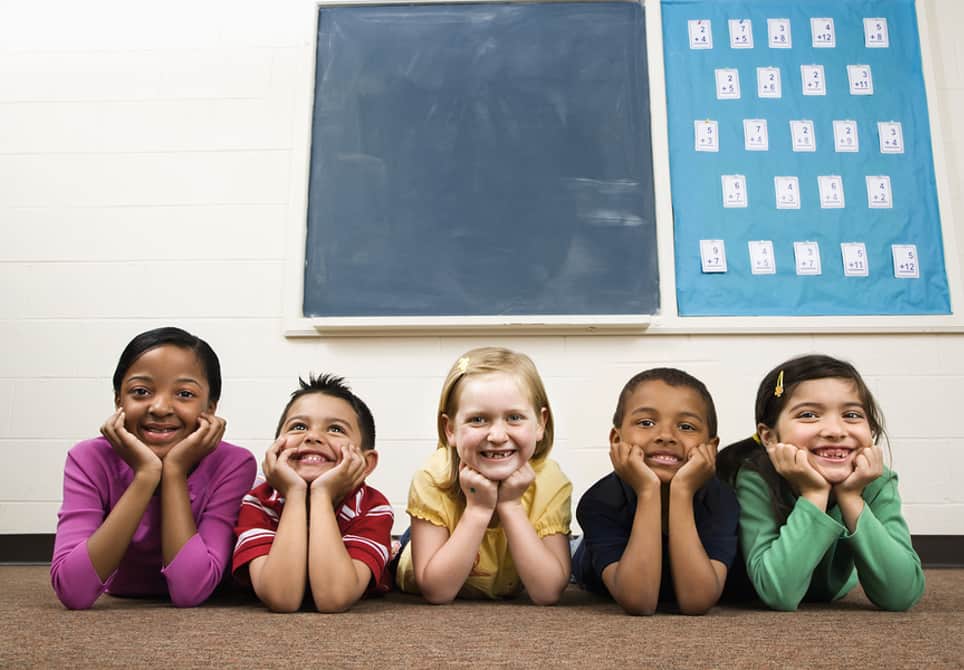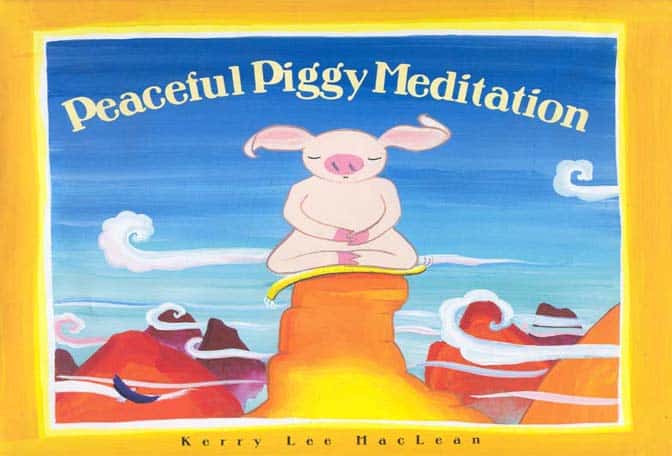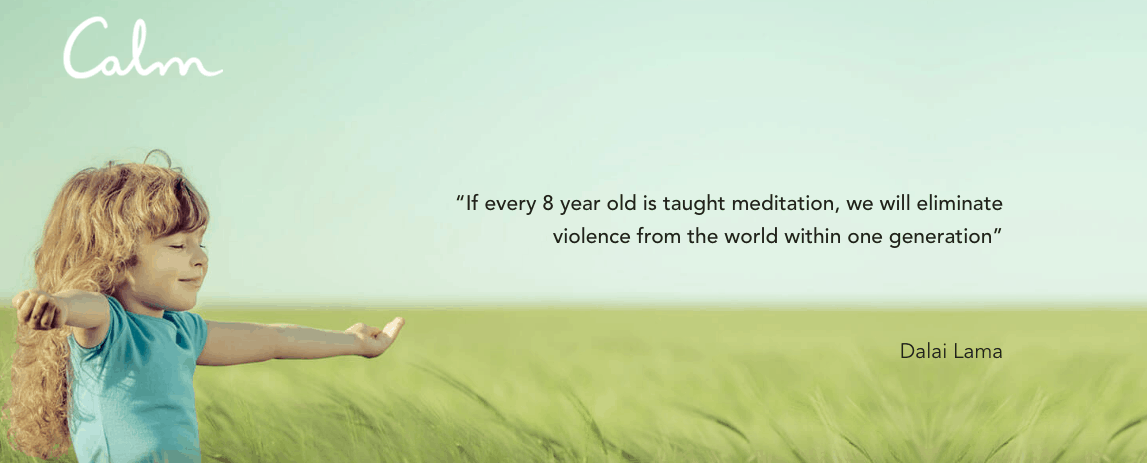Cultivating Mindfulness in the Classroom

When I was in Junior High, I had a teacher who led us through a “blue goo” exercise before we had a big test. Sitting in our desks, we’d all close our eyes and he’d calmly instruct us to imagine waves of thick blue liquid moving through each part of our bodies until we were totally relaxed from head to toe.
I don’t remember much about the actual words he used or even if this happened once, twice or forty times that year. But what I do remember is that as teenage kid, closing my eyes and experiencing “guided imagery” or “guided visualization” was something totally unlike anything else I had ever experienced in school.
As it turns out, that teacher 25 years ago was on to something. There’s new research–and a slew of recent articles making their rounds–confirming the positive effects of teaching kids skills like meditation and integrating practices to develop mindfulness into the school day.
Why Mindfulness Matters
Mindfulness: a mental state achieved by focusing one’s awareness on the present moment, while calmly acknowledging and accepting one’s feelings, thoughts, and bodily sensations, used as a therapeutic technique.
Mindfulness goes beyond the stereotypes that might pop into your mind when you hear words like “meditation” and “guided visualization.” Teaching kids how to be more mindful and aware of their thoughts and feelings has been shown to improve memory and attention, boost learning outcomes, decrease behavior issues and more.
A New York Times piece points to three studies: a 2015 study of 4th and 5th grade students who showed improvements in executive functions (like cognitive control, working memory, cognitive flexibility) and improved math grades after participating in a four-month meditation program; a study published recently in the journal Mindfulness that found similar improvements in mathematics in 5th graders with ADHD and a study of elementary school children in Korea showing that eight weeks of meditation lowered aggression, social anxiety and stress.
A recent article in The Atlantic discusses additional benefits to mindfulness programs including increased happiness, optimism, empathy and compassion with decreasing incidents of bullying and better conflict resolution skills. Another piece in The Atlantic reviews the research base, stating:
“The body of scientific research illustrating the positive effects of mindfulness training on mental health and well-being—at the level of the brain as well as at the level of behavior—grows steadily more well-established: It improves attention,reduces stress, and results in better emotional regulation and an improved capacity for compassion and empathy. Brain-imaging studies at Harvard and Mass General Hospital have shown that long-term mindfulness training can help thicken the cortical regions related to attention and sensory processing, and may offset thinning of those areas that typically comes with aging. Mindfulness is widely considered effective in psychotherapy as a treatment not just for adults, but also for children and adolescents with aggression, ADHD, or mental-health problems like anxiety.”
There’s also potential that mindfulness practices can combat the “toxic stress” experienced by many students in poverty. A recent MindShift/KQED blog offers insight into such practices and students in poverty, pointing to the first phase of a three-year-study of thousands of students participating in mindfulness programs in high poverty Chicago schools. (Check out our podcast with Paul Tough discussing his latest book for more on his work related to kids in poverty.)
According to an exploration of mindfulness practices in schools by CNN, practices such as meditation also offer an anecdote to the mounting pressure and stress that students (and particularly teens) are experiencing across the board. At Portland’s Woodrow Wilson High School, a school featured by CNN, principal Brian Chatard explains the benefits of their partnership with Peace in Schools explaining, “What it has enabled us is a proactive approach to dealing with the issues that we only end up dealing with reactively.”
Tools & Tips for Cultivating Mindfulness
 There are many reasons to integrate mindfulnesses practices into your school or classroom. Research confirms that even a few minutes each day is enough to see the benefits, and you don’t need to be an expert in any of these skills or practices.
There are many reasons to integrate mindfulnesses practices into your school or classroom. Research confirms that even a few minutes each day is enough to see the benefits, and you don’t need to be an expert in any of these skills or practices.
From short scripts, read-aloud books and videos to multi-year partnerships and programs, here are some ideas to get you started.
Books like Peaceful Piggy Meditation by Kerry Lee MacLean are a good entry point for younger kids, because a read-aloud book is a familiar format to both teachers and students.
Videos like the short film Just Breathe can be a great conversation starter to help kids and their families understand why mindfulness matters.

Seek inspiration from other schools like the “Zen Room” in this Massachusetts high school–complete with mats, blankets, music and teachers trained in cultivating mindfulness. Not a realistic option for your school? Try a simple “Peace Corner.” This is a common part of most Montessori classrooms that you can create anywhere. Because she enjoyed this space so much in her Montessori school, my daughter insisted we set one up at home. We have a shelf with a Kids Yoga card deck, a meditation chime, a singing bowl, CDs and a nearby meditation cushion.
Don’t be afraid to start slowly with simple exercises like guided visualization. Even a quick search can turn up easy scripts for many situations (like this one for anxiety and stress). There are also a number of great teacher-created blogs like Education’s Voice dedicated to equipping educators with the tools to get started. When I was a classroom teacher I used really simple cues like “everyone freeze and breathe” when the energy of my students was too frenetic or getting out of control. This simple moment of mindfulness is also a great parenting hack to diffuse a conflict between siblings, friends, etc.
Simply playing peaceful music or nature sounds in the background during independent work time also goes a long way toward setting a calming environment. I remember seeing how students’ postures would totally change as they relaxed just a few minutes after hitting “play.” I use the same method when I’m feeling particularly stuck or stressed during my workday by picking from one of the Spotify playlists for this exact purpose.

There are also many formal programs that schools can explore as options. I just learned that my daughter’s school in a large urban district will implement the Mindful Music Moments program in partnership with the Cincinnati Symphony Orchestra and Cincinnati Opera. Every morning students listen to a classical music piece over the announcements and practice mindful listening skills according to provided prompts. The program also integrates VIA Character Strengths, complete with classroom materials.
A piece on mindfulness in education is just not complete without homage to one of the early pioneers of cultivating mindfulness in education. Thich Nhat Hanh’s Plum Village is a Mindfulness Practice Center with multiple initiatives that support the teaching and learning of mindfulness. The Wake Up Schools Initiative provides training for teachers and leaders for classrooms and communities. Check out the video Happy Teachers Will Change the World for more about Plum Village teacher retreats. The book and accompanying CD “Planting Seeds: Practicing Mindfulness with Children” is also a great one for teachers and would make an excellent focus for a professional learning book circle. It’s overflowing with ideas!
Interested in learning more about mindfulness in education? Explore organizations like the Association for Mindfulness in Education (AME), The Mindfulness in Education Network and Mindful Schools for resources, research, events and opportunities to dive deep on these topics. Join the social media conversation using #MindfulEd and #mindfulness + #kids.
Cultivate Your Own Mindfulness
Pause now for a moment and observe how your body is feeling. Are you tense? Relaxed? Sitting at the edge of your chair? Slouching at your desk? Tightening your jaw? Hunched over your phone screen?
Now sit up straight, close your eyes and take five deep breaths–pausing for a moment between each inhalation and exhalation.
How do you feel now? Usually it only takes a quick “reset” like this to experience a calmer body and more active mind.
Now visualize kids in a classroom. Chances are you either envision a room of kids sitting in rows looking down at their desks or a busy room of active kids, moving from one thing quickly to the next. Either way, consider how the energy of the room would shift if kids did the same or similar exercise–to calm their bodies and activate their minds.
Isn’t that an ideal condition for learning?
For more, see:
- How 2 Minutes of SEL Can Change the Tone for the Day
- Why It Is Imperative to Assess Social Emotional Learning Noncognitive Skills
- 10 Ways Educators Can Use SEL Measurement and Assessment for Student Success
Stay in-the-know with all things EdTech and innovations in learning by signing up to receive the weekly Smart Update.







Tammie Prince
I am completely committed to sharing mindfulness practice in the classroom. I have been doing training, running a blog, www.educationsvoice.wordpress.com, Twitter @Ed_Tmprince and Facebook site, Education's Voice - Mindfulness https://www.facebook.com/educationsvoice/ and now writing a book for Bloomsbury Publishing on Mindfulness in the Classroom.
We need more people taking up this strategy for the good of our children!
Carri Schneider
Thanks Tammie! It's great to meet you. I added a link to your great blog! Good luck with your book project! Here's more information about our guest blog policy. We'd love for you to share more about your work. http://www.gettingsmart.com/gettingsmart-staging/gettingsmart/guest-posting-policy/